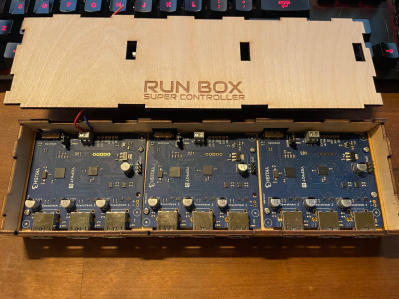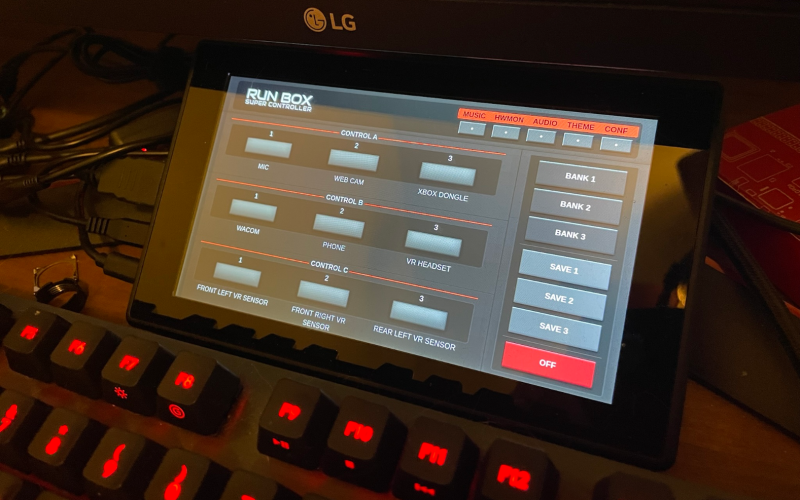One of the most useful features of the Universal Serial Bus is its hot-plugging capability. You simply plug in your device, use it, and unplug it when you’re done. But what if you’ve got a huge number of USB devices? You might not want to use all of them all of the time, but repeatedly unplugging and re-plugging them is inconvenient and wears out the connectors. [Matt G] fixed this problem by building the RUNBOX: a USB hub that can be controlled through a touchscreen.
The USB hub part consists of a Yepkit YKUSH 3, which is a USB 3.1 hub that support software-controlled disconnecting of devices. [Matt] hooked up a Raspberry Pi to its ports so that it could switch devices on and off through a software command. To make it more user-friendly he added a touch screen controller and created an app using the Electron framework. This allowed him to enable or disable separate devices with a single touch: turn on the mic and webcam for video-conferencing, or fire up the VR headset and game controller for a gaming session.
 The modified USB hub is housed in a laser-cut enclosure with plenty of space to hook up a variety of USB devices. The touchscreen neatly fits just above [Matt]’s keyboard; this setup was inspired by head-down displays used in aircraft which similarly use a small additional screen for peripheral functions.
The modified USB hub is housed in a laser-cut enclosure with plenty of space to hook up a variety of USB devices. The touchscreen neatly fits just above [Matt]’s keyboard; this setup was inspired by head-down displays used in aircraft which similarly use a small additional screen for peripheral functions.
Although we’ve seen switchable USB hubs before, they usually require you to either press a manual switch or run dedicated software on your PC. We’ve also seen other sleek builds combining a Raspberry Pi with a USB hub.
















But why? you can buy a 10 or 20 port USB hub with switches for each port for cheap on amazon.
Because the USB switch is on the floor behind the PC behind the boxes of old pictures in the back of the closet in the attic and you want to turn off the USB printer because it’s constantly spewing out of paper messages and you know already but you haven’t been to the store to pick up a ream of paper and you just want the messages to stop already.
I think any person can find their own reason why such a device would be useful.
Do you carefully label those switches so you don’t flip the wrong one? Do you print up directions so your wife knows what to do? Will you remember which switch goes to which device a year from now? By the time you’ve made your labels and printed your instructions and taught your family members what to do, you might as well write some software to handle it all.
Excuses… excuses… Any HaD hackers could easily wire up a switch panel to those hidden hubs.
Quite. And in the spirit of this site, you could even hack it to control the switches from an Arduino!
I can see a use for this.
I have a lot of usb devices. multiple cameras, mics, microscopes, oscopes etc. I often unplug the ones i’m not using for power and ui clutter reasons (at least one of my microscopes borks teams calls).
It would be nice to press a “i’m doing x project” button which powers the usb lamp on, turns on the oscope, powers the rpi/arduino etc. (I use hubs for this at the moment, unplugging the whole hub. it sucks.)
You could even use it for a crude power switch using not much more than a relay and resistor. Would be handy to switch the soldering iron on too!
Sounds pretty useful to me!
I kind of doubt that the power used in standby by most USB devices is going to be more than the Pi + touchscreen. A small MCU and epaper maybe, but with this setup it’s unlikely to save any power (especially since you now have this system running all the time, on top of the power drawn by decies)
Because this site is Hackaday not Buyaday? Maybe some people prefer to learn and make something rather than just buying an object, and also this can be flexibly modified through software for specific applications while a cheap usb hub with switches by itself cannot.
I can see a few uses for this…. hmmm
In my datacenter we had a virtual tape library (COPAN) which had the benefits of both disks and tapes: tapes does not use power when not used but have sequential access, and hard drives uses lots of power but have random access. This apparatus shut down disks when not used, and wake up them when needed, which was perfect for small files (where big files went to true tape libraries).
Note: we use SGI/HPE DMF (Data Migration Facility) for managing a quite big (12 PB) HSM (Hierarchical System Management) filesystem (it automatically secures and move “hot” data from tape to HDD, and “cold” data from disk to tape)
I made a similar system using usb to sata adapters and a lot of “old / small” HDDs, and scripted to shut down disks (using hdparm) when not needed. This allowed me to have a backup system which was both “fast” (when used) and quite “green”. But this remaining problem is that both usb to sata adapters and HDD electronic sucks too much energy.
Such a programmable hub would be a great deal if it wasn’t so expensive ($90 is huge from my point of view).
Any other usb hub with programmable abilities exists ?
Note: backup software: bacula, virtual tape library (to emulate tapes): mhvtl
Some of the USB hub chips (e.g. GL3520 for 3.0 hub) have individual enable pin to control power switches/OC protection to each port. Often this feature is not used on cheap Hubs nor the reduced pin count package of these hub controller chips.
The usual vendoirs e.g. Ti, Maxim etc make chips for switching power. It is a matter of running the power from each port to them and wiring to the Hub controller. The power control is part of the USB power management, so they can be controlled from the OS level.
Many slightly-less-than-cheap hubs do support per-port-power-control. Check the page for the uhubctl project for a list of known working hubs, and a great tool for managing hub power: https://github.com/mvp/uhubctl
FYI: https://hackaday.com/2014/02/05/software-controlled-per-port-power-switching-for-usb-hubs/